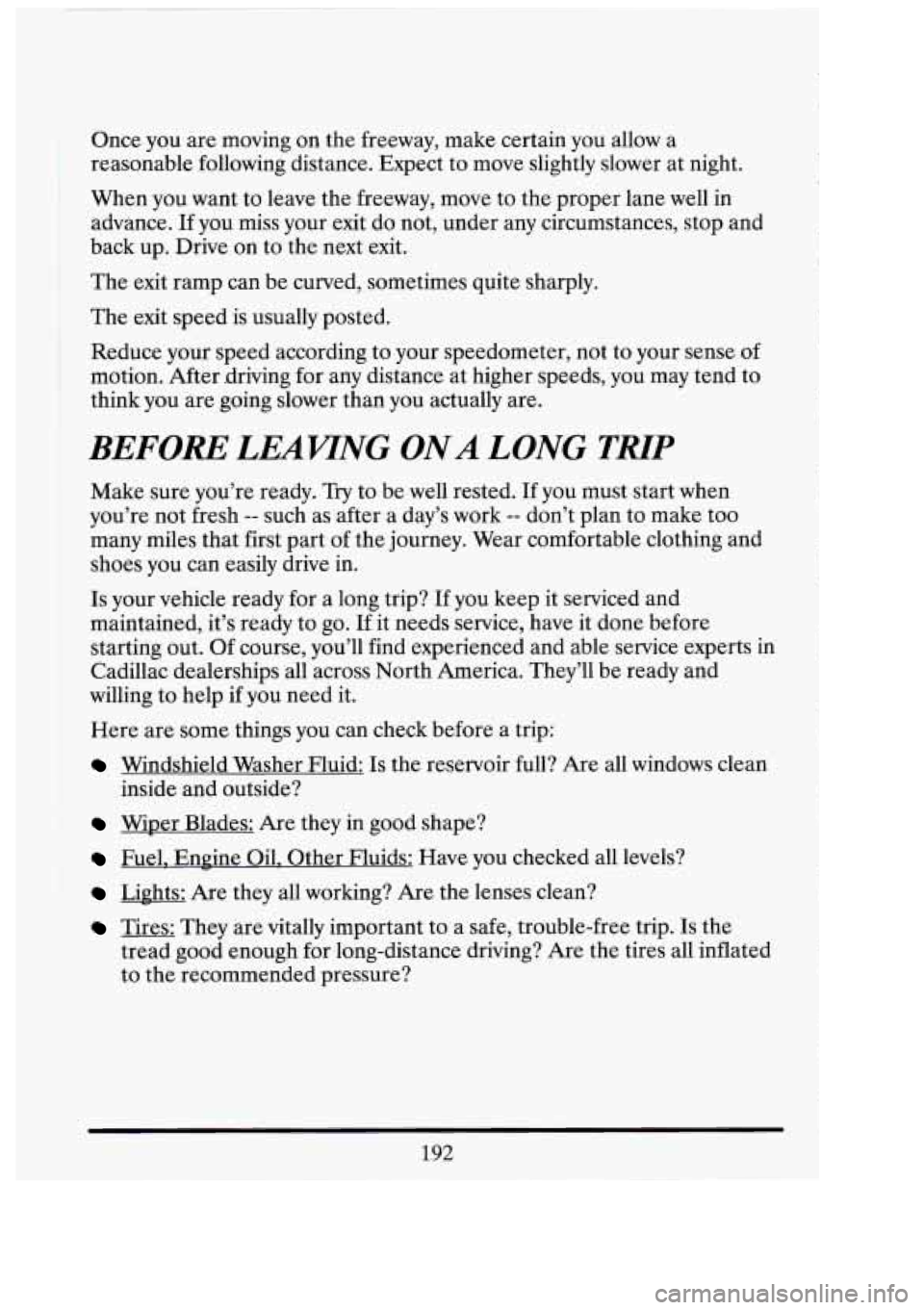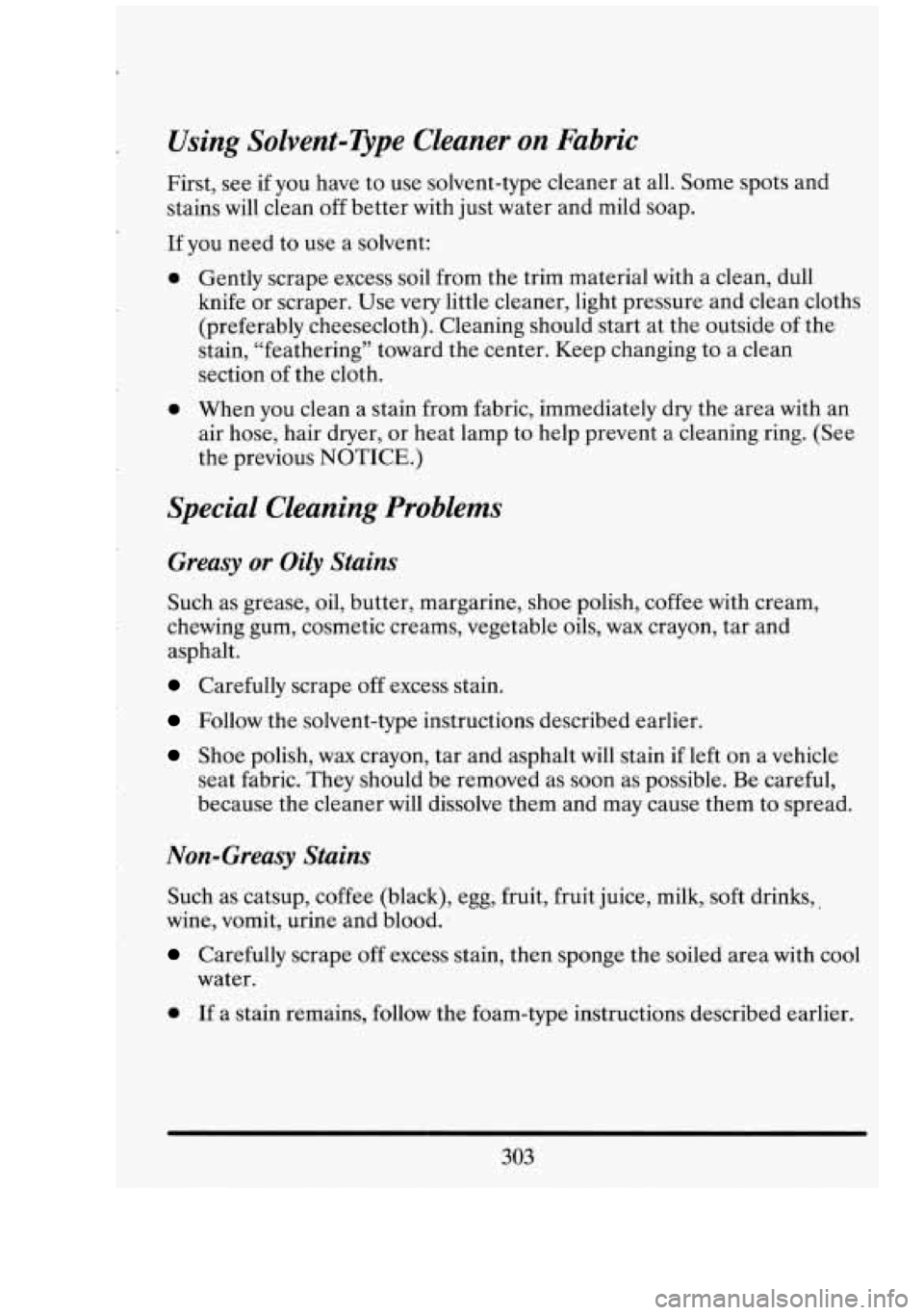Page 150 of 398
r Oil Pressure Light
This light tells you if
there could be a
problem with your
engine oil pressure.
The light goes on when you turn your key to “Run” or “Start.” It goes
off
once you start your engine. That’s just a check to be sure the light works.
If it doesn’t, be sure to have it fixed so it will be there to warn you if
something goes wrong.
When this light comes on and stays on, it means oil isn’t going through
your engine properly.
You could be low on oil, or you might have some
other oil problem.
NOTICE:
Damage to your engine from neglected oil problems can be
costly and is not covered by your warranty.
137
Page 205 of 398

I
Once you are moving on the freeway, make certain you allow a
reasonable following distance. Expect to move slightly slower at night.
When you want to leave the freeway, move to the proper lane well in
advance.
If you miss your exit do not, under any circumstances, stop and
back up. Drive on to the next exit.
The exit ramp can be curved, sometimes quite sharply.
The exit speed is usually posted.
Reduce your speed according to your speedometer, not to your sense of
motion. After driving for any distance at higher speeds, you may tend to
think you are going slower than you actually are.
BEFORE LEAWNG ONA LONG TMP
Make sure you’re ready. Try to be well rested. If you must start when
you’re not fresh
-- such as after a day’s work -- don’t plan to make too
many,miles that first part of the journey. Wear comfortable clothing and
shoes you can easily drive in.
Is your vehicle ready for a long.trip? If you keep it serviced and
maintained, it’s ready to go.
If it needs service, have it done before
starting out. Of course, you’ll find experienced and able service experts
in
Cadillac dealerships all across North America. They’ll be ready and
willing to help if you need it.
Here are some things you can check before a trip:
Windshield Washer Fluid: Is the reservoir full? Are all windows clean
Wiper Blades: Are they in good shape?
Fuel, EnEine Oil. Other Fluids: Have you checked all levels?
Lights: Are they all working? Are the lenses clean?
inside
and outside?
Tires: They are vitally important to a safe, trouble-free trip. Is the
tread good enough for long-distance driving?
Are the tires all inflated
to the recommended pressure?
Ql
cl‘ I
GI
192
Page 316 of 398

r_ Using Solvent-Type Cleaner on Fabric
First, see if you have to use solvent-type cleaner at all. Some spots and
stains
will clean off better with just water and mild soap.
If you need to use a solvent:
0 Gently scrape excess soil from the trim material with a clean, dull
knife or scraper. Use
very little cleaner, light pressure and clean cloths
(preferably cheesecloth). Cleaning should start at the outside of the
stain, “feathering” toward the center. Keep changing
to a clean
section of the cloth.
0 When you clean a stain from fabric, immediately dry the area with an
air hose, hair dryer, or heat lamp
to help prevent a cleaning ring. (See
the previous NOTICE.)
Special Cleaning Problems
Greasy or Oily Stains
Such as grease, oil, butter, margarine, shoe polish, coffee with cream,
chewing gum, cosmetic creams, vegetable oils,
wax crayon, tar and
asphalt.
Carefully scrape off excess stain.
Follow the solvent-type instructions described earlier.
Shoe polish, wax crayon, tar and asphalt will stain if left on a vehicle
seat fabric. They should be removed as soon as possible. Be careful,
because the cleaner will dissolve them and may cause them to spread.
Non-Greasy Stains
Such as catsup, coffee (black), egg; fruit, fruit juice, milk, soft drinks,.
wine, vomit, urine and blood.
Carefully scrape off excess stain, then sponge the soiled area with cool
water.
0 If a stain remains, follow the foam-type instructions described earlier.
303
Page 328 of 398

FUSE USAGE CHART
0
FOR MORE INFORMATION, SEE OWNER’S MANUAL
UNDERHOOD (U/H) ELECTRICAL CENTER BODY 1 (SO AMP)
I/P FUSE BLOCK
#3 PWR. SEAT CIRCUIT
BREAKER (30 AMP)
#36 TRUNK PULL-DOWN
#37 HAZARD LTS. (20 AMP)
(15 AMP)
#39 PWR. LUMBAR (20 AMP)
#40 HEATED SEAT (20 AMP)
#44 STOP LTS. (20 AMP)
#45 PWR. LOCK (20 AMP)
BODY 2 (50 AMP)
I/P FUSE BLOCK
- #21 RAP BAT (25 AMP)
- #22 HVAC MDL. (25 AMP) - #26 ELC. SENS. (20 AMP) - #27 D/INT LTS. (1 5 AMP) - #28 FRT CIG. (1 0 AMP) - #29 RR. CIG. (20 AMP) - #30 EBTCM (25 AMP) - #33 HVAC BAT (10 AMP) - #34 CCM BAT (10 AMP) - #35 PWR. MIR. (10 AMP) - #2 CIRCUIT BREAKER - RAP RLY (30 AMP) 3 - ION 1 (50 AMP) - I/P CONCEALED FUSE - RKE/UTD SA - I/P FUSE BLOCK - #6 T/SIS-ICA - #7 EBTCMDPS (1 0 AMP) - #8 RAP WPR. (25 AMP)
- #10 WIPER (25 AMP) - #9 RADIO (10 AMP)
- #li I/P IiDC (10 AMP) - #12 ELC. IGN. 1 (10 AMP) - #13 CHIME (10 AMP) - #14 CCM IGN 1 (10 AMP) - #15 AIR BAG (1 5 AMP) - #24 STARTER, U/H ELC. CNTR. - #15 PCM/IGN (10AMP) - #16 INJ 1 (10AMP) - #17 EMISSIONS (1 0 AMP) - #18 INJ 2 (10 AMP) 4 - ION 3 (40 AMP)
I/P FUSE BLOCK
- #16 GEN. (10 AMP) - #17 MEM. SEAT (10 AMP) - #18 CCM IGN 3 (10 AMP) - #19 RAP PWR. (30 AMP) - #20 A/C COMF! (10 AMP) - #25 HVAC IGN (10 AMP)
- BRAKE PRESSURE 5 - ABSRC (60 AMP)
MODULATOR VALVE (BPMV) 6 - NOT USED 7 - SCNDRY CLG FAN (40 AMP) - SECONDARY COOLING FAN
CNTRL. RELAY
8 - PRIMRY CLG FAN (40 AMP) - PRIMARY COOLING FAN
9 - LEVEL CNTRL. (30 AMP) CNTRL. REIAY
- AUTOMATIC LEVEL CNTRL.
10 - ENGINE (30 AMP) AIR COMR
- #13 PCM/FUEL PUMP (15 AMP) - #14 AIR PUMP (20 AMP)
11 - I/P FUSE BLOCK CIRCUIT
BREAKER
- #5 HDLTS (20 AMP) - #31 PARK LTS. (20 AMP) - #32 HORN (25 AMP) 12 - EMPTY 13 - PCM FUEL PUMP 115 AMP) - FUEL PUMP RELA? - FUEL PUMP AND ENGINE OIL PRESSURE INDICATOR SWITCH
MDL (PCM) - POWER TRAIN CONTRL.
14 - AIR PUMP (20 AMP) - SECONDARY AIR IN (AIR)
PUMP RELAY
15 - PCM IGN (10 AMP) - IGN COIL - ELECTRONIC TRANS. - (PCM) POWER TRAIN
CNTRL. MDL.
16- INJ 1 110AMP) ~ - FUEL I‘NJ 1,4,6,7 17 - EMISSIONS (10 AMP) - (A.I.R.) PUMP‘RELAY . - MASS AIR FLOW (MAF)
- HEATED OXYGEN SENSOR’S - EVAPORATIVE EMISSIONS
SENSOR
CANNISTER PURGE
SOLONOID VALVE
18- INJ 2 (10 AMP) - FUEL INJ 2,3,5,8
315